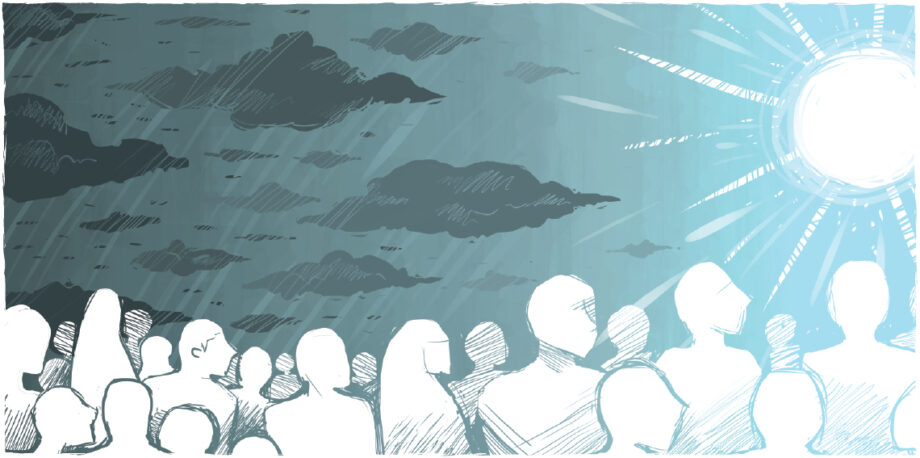January 19, 2016 — Undoubtedly, the recent Paris climate agreement achieved at COP 21 deserves recognition as the world’s first multilateral accord to curb climate change. But weeks after the historic negotiations, it’s time to address something the final document failed to: the tens of millions of climate refugees expected to arrive at our collective doorsteps by 2050.
Governments such as China and Mozambique have already started displacing certain populations in anticipation of climate changes. But many vulnerable countries, such as Bangladesh, whose people will most likely need to move lack the resources to relocate entire populations to a new region or nation. Bangladesh is being ravaged by flooding, cyclones, storm surges, salination, erosion, rising seas and more. Of the country’s 64 districts, at least 24 are already producing climate-displaced people. At the same time, India is building a 2,500-mile (4,000-kilometer) barbed wire fence along the Bangladeshi border to dissuade migrants.
It’s difficult to predict how many people will be displaced around the world in years and decades to come. In 1985 the United Nations Environment Programme estimated that 30 million people had been displaced by environmental catastrophes. In 1995, British environment and development consultant Norman Myers estimated that 200 million people or more could be at risk of displacement by 2050, with 26 million from Bangladesh alone. More recent estimates of the number of “environmental migrants” to be expected by 2050 range from 150 million to 300 million.
Whatever the numbers, it is vital that refugees not be viewed as enemies at the gate, but as agents adapting proactively to climate anomalies beyond their control. In fact, it is in the world’s best interest — not just the refugees’ — to start considering human mobility as a climate adaptation tool under an international political framework. Using migration as an adaptation strategy will help the world avoid crises such as that occurring in Europe and elsewhere, where refugees fleeing Syria, in part due to climate-related anomalies that contributed to and escalated instability, have been met with a wide range of responses, from acceptance to hostility. Instead, future migrations could ensure climate refugees the right to a safe and planned transition in which they have a voice to advocate for themselves.
Debating the Definition
In order to accomplish this, it’s imperative that climate refugees receive the protections granted under international law to most other refugees. Environmental scientists and academics define climate refugees as people who can no longer guarantee safety or a secure livelihood in their own countries because of drought, soil erosion, desertification, sea-level rise or other environmental issues. But this is an academic definition, not a legal one.
The reality is that climate displacement is a form of persecution.Under international law, climate refugees are not refugees at all. The word “refugee” gives asylum seekers legal status under the 1951 Geneva Convention Relating to the Status of Refugees. But that definition only grants human rights protections to persons fleeing political persecution. Since climate refugees, as currently defined, are not fleeing political persecution, this convention can rarely protect them. The United Nations High Commissioner for Refugees tends to use the term “climate displaced persons” instead. Some support the term “climate migrants,” but this is problematic as well because “migrants” implies people move willingly.
But the reality is that climate displacement is a form of persecution, because globally, wealthy nations have contributed the bulk of greenhouse gases, and developing nations have suffered most of the consequences. As François Gemenne, researcher on environmental geopolitics and migration governance at Sciences Po, an international research university in France, put it at a side event at COP 21, “Most humans are the victims, not the agents, of climate change, so we should consider [climate change] a form of political persecution. … [C]limate change is just another form of violence we inflict upon them.”
Legalizing the term “climate refugee” under some sort of global governance system such as that of the United Nations Framework Convention on Climate Change is our best bet to close the legal gap in which climate-displaced people around the world have no name and no safety net in international policy-making. The term “climate refugee” gives human rights protections, legitimizes migration as an adaptation strategy and makes climate change grounds for political persecution.
Who’s in Charge?
Countless organizations are working creatively to fill this legal void. The Council of Europe Parliamentary Assembly’s Committee on Migration, Refugees and Population lobbies for adding a “right to healthy and safe environment” as part of the Europe Convention of Human Rights. Other groups, like the Nansen Initiative — launched in 2012 by Norway and Switzerland to build a consensus on principles for domestic, regional and international policy-making on cross-border migration — wants a nonbinding protection agenda based on international cooperation, standard treatment of climate refugees and funding mechanisms for resettlement.
At another side event in Paris, Walter Kaelin of Nansen said that these topics are just “too sensitive” for the COP 21 international negotiations. Apparently he was right. In the Paris agreement, the UNFCCC politely refused to use any term for climate refugees and tucked the issue into its ambiguous “Loss and Damage” clause. Unfortunately, this clause doesn’t accomplish what all small island nations hoped it would; it merely suggests implementing a task force to “develop recommendations for integrated approaches to avert, minimize and address displacement related to the adverse impacts of climate change.” For this and other reasons Gemenne says, “I’m not sure if we should hope to see migration policed by the UNFCCC framework.”
In order to achieve planned migrations, the world must adopt a legal definition for the use of the term “climate refugees.”To be fair, world leaders have shown more political will to address this issue now than ever before. In opening speeches at COP 21, most world leaders emphasized the links between climate change and security. In the wake of the tragic Paris terrorist attacks in November, President François Hollande of France said, “What is at stake at this climate conference is peace.” Many scholars and politicians support the idea that issues related to climate change are partly to blame for the current situation in Syria, including German chancellor Angela Merkel, who has allowed more than 1 million Syrian refugees to enter her country. But in order to achieve planned migrations, the world must adopt a legal definition for the use of the term “climate refugees.” Without one, ambiguity and uncertainty will continue to immobilize world leaders.
Refugee Perspectives
The issue is complicated, though, because many climate refugees don’t want to be labeled as such. To these people, becoming a refugee means losing agency and becoming a marginalized victim. At COP 21, Anote Tong, the president of Kiribati, a vulnerable small island nation, said, “I always cringe when someone says [climate refugee].”
Kiribati is developing a “migrating with dignity” policy to facilitate planned migrations. As Koko Warner of the Institute for Environment and Human Security at United Nations University put it during a panel discussion in Paris, “whether people stay or go, it needs to be dignified.” To that end, the Kiribati government is working closely with host communities in Australia and New Zealand to facilitate cultural assimilation with course offerings in vocational fields and English language scholarships. This program provides a smooth transition for climate refugees, showing that even without a legal definition migration can be a successful climate adaptation strategy. But, all transitions won’t be smooth, especially when they are due to rapid-onset disasters, so people fleeing their homes because of climate-related issues need the protection the term “refugee” carries.
“Enough talk, let’s have action. … We are just trying to find a way to stay above the water.” – Anote TongOther vulnerable nations push for the legalization of the term “climate refugee” despite its negative connotations as a way to gain human rights protections allowed to other refugees. Additionally, many small island nations see it as an opportunity to get restitution from developed countries, which they believe they deserve for bearing the unequal effects of the developed world’s greenhouse gas pollution.
Meanwhile, while we debate definitions and governance frameworks, vulnerable nations are calling for immediate action. Displacement due to disasters has increased fourfold since the 1970s. Tong said at a COP 21 meeting, “Enough talk, let’s have action. … We are just trying to find a way to stay above the water.”
As the number of refugees grows, the world will have to adapt to this new reality. Politicians and others need to address this issue on an international scale by creating a road map allowing for migration to be used as an adaptation strategy in our rapidly changing world. Only then will migrations mature from being sudden, forced and unwelcomed tragedies to planned, dignified and pragmatic ways to adapt to a changing climate. ![]()
Editor’s note: The views expressed here are those of the author and not necessarily of Ensia. We present them to further discussion around important topics. We encourage you to respond with a comment below, following our commenting guidelines, which can be found here. In addition, you might consider submitting a Voices piece of your own. See Ensia’s “Contact” page for submission guidelines.
Kayla Walsh produced this Voices piece as a participant in the Ensia Mentor Program. Her mentor for the project was Ensia senior editor David Doody.
Ensia shares solutions-focused stories free of charge through our online magazine and partner media. That means audiences around the world have ready access to stories that can — and do — help them shape a better future. If you value our work, please show your support today.
Yes, I'll support Ensia!

Why should we put any stock in their latest predictions of catastrophe?
Climate refugees my patoot.
Stop. If these people did what we did, they could adapt to the conditions in their own countries. Give them the energy and ability to provide for themselves.
However, this still does not pay enough special attention to persons displaced by climate change.
There are many organizations across the world focused on human mobility and providing resources for persons to stay in their original countries. John Vidal wrote this great piece for the Guardian explaining how our aid is not enough, and that countries hope for faster action after the Paris Climate Accord. https://www.theguardian.com/global-development/2016/oct/07/poor-countries-urge-fast-action-paris-climate-deal-to-stop-catastrophic-warming?CMP=share_btn_tw
Notably, the majority of human migration happens within one country's own border. This issue of human mobility through a climate change lens is on the docket for United Nations Conference on Climate Change COP22 in Marakesh, Morocco this November, 2016.